Introduction
Systematic field-survey was carried out in the territories of Contrada Termine and Contrada Felci within the comune of Pignataro Interamna. This was done by parallel lines and by putting the surveyors (5-9) at a distance of 3-5 m from each other (intensive survey). Basic unit of the survey was the individual field defined as a consistent and bounded land plot with even visibility conditions (Unità Topografica – UT / lit. ‘Topographic Unit’). The ploughsoil assemblage distribution model here adopted hinged on site and offsite notions. Site was defined as a higher concentration of archaeological material with respect to the general situation within the Unità Topografica and therefore possible indicator of a past human settlement. Offsite was defined as a more diffused and less homogenous spread of archaeological material within the Unità Topografica, but nonetheless an indicator of some past human activity (e.g. manuring).
Conditions in the landscape in September (e.g. ploughing) were much varied and often inadequate in terms of surface visibility. Because of this and in order to achieve the best possible results, the systematic survey was carried out in limited and discontinuous areas. Much better conditions were met in October, us allowing us to fill the gaps in the coverage. All sites were georeferenced by way of a Garmin eTrex Venture HC GPS receiver, whilst altitudes were derived from the Carta Tecnica Regionale del Lazio Ril.1991 (i.e. the Regional Technical Map from Lazio 1991 edition, 1:10000).
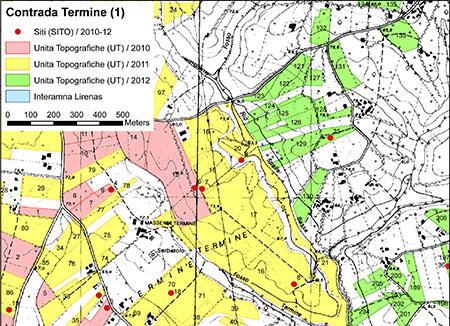
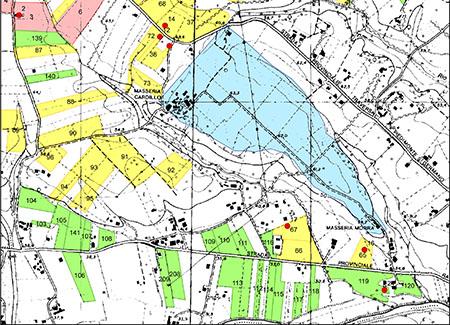
Fig.1: Distribution of Sites (SITO) and Topographic Units (UT) across Contrada Termine (on Carta Tecnica Regionale del Lazio Ril. 1991 – Elementi 403130 and 403140)
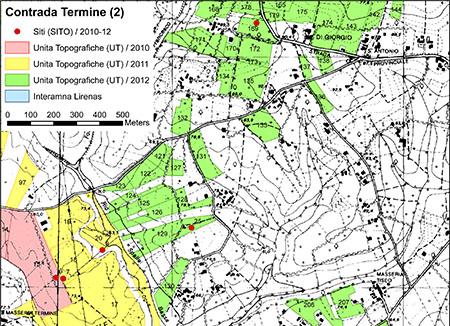
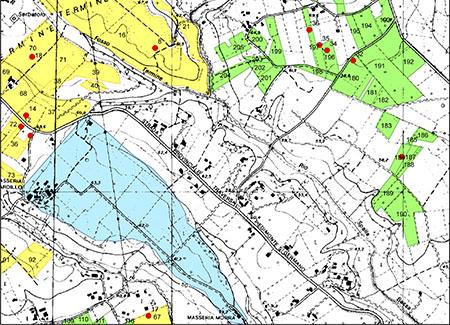
Fig.2: Distribution of Sites (SITO) and Topographic Units (UT) across Contrada Termine (on Carta Tecnica Regionale del Lazio Ril. 1991 – Elementi 403130 and 403140)
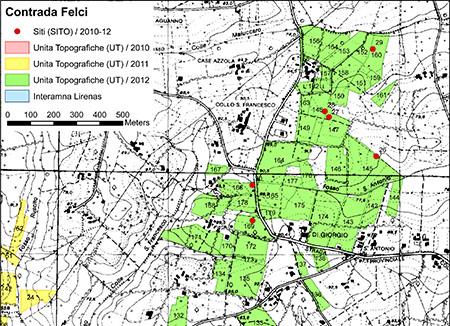
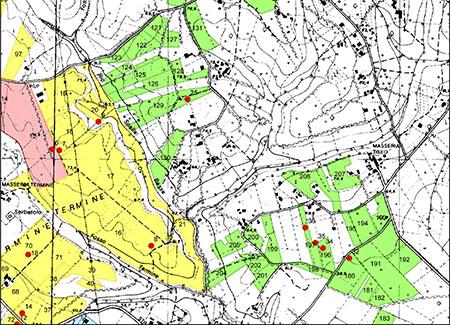
Fig.3: Distribution of Sites (SITO) and Topographic Units (UT) across Contrada Felci (on Carta Tecnica Regionale del Lazio Ril. 1991 – Elementi 403090, 403100, 403130 and 403140)
Results
About 110 ha were surveyed at Contrada Termine and Contrada Felci (Fig. 1-3), for a total of 107 Topographic Units [UT 103-209], all characterised by excellent visibility conditions (generally recent ploughings):
- UT 103: Archaeologically sterile area;
- UT 104: background-noise off-site (Roman period);
- UT 105: background-noise off-site (AD 75-225);
- UT 106: background-noise off-site (Roman period);
- UT 107: Archaeologically sterile area;
- UT 108: background-noise off-site (Roman period);
- UT 109: background-noise off-site (200 BC – AD 500 and medieval period);
- UT 110: background-noise off-site (200 BC – AD 300);
- UT 111: background-noise off-site (Roman period);
- UT 112: Archaeologically sterile area;
- UT 113: background-noise off-site (Roman and medieval period);
- UT 114: background-noise off-site (AD 200-300);
- UT 115: Archaeologically sterile area;
- UT 116: background-noise off-site (AD 1-50);
- UT 117: background-noise off-site (Roman period);
- UT 118: Archaeologically sterile area;
- UT 119: background-noise off-site / offsite of SITO 24 (AD 1-600 and medieval period);
- UT 120: Archaeologically sterile area;
- UT 121: background-noise off-site (200 BC – AD 550);
- UT 122: Archaeologically sterile area;
- UT 123: Archaeologically sterile area;
- UT 124: background-noise off-site (100 BC – AD 100);
- UT 125: background-noise off-site (Roman period);
- UT 126: background-noise off-site (Roman period);
- UT 127: background-noise off-site (Roman period);
- UT 128: background-noise off-site (275-150 BC);
- UT 129: background-noise off-site / offsite of SITO 25 (Roman period);
- UT 130: background-noise off-site (Roman period);
- UT 131: background-noise off-site (200 BC – AD 200);
- UT 132: background-noise off-site (AD 1-300);
- UT 133: background-noise off-site (AD 300-500);
- UT 134: Archaeologically sterile area;
- UT 135: background-noise off-site (Roman period);
- UT 136: background-noise off-site (Roman period);
- UT 137: Archaeologically sterile area;
- UT 138: background-noise off-site (Roman period);
- UT 139: background-noise off-site (Roman period);
- UT 140: background-noise off-site (Roman period);
- UT 141: background-noise off-site (Roman period);
- UT 142: background-noise off-site (50 BC – AD 150);
- UT 143: background-noise off-site (AD 400-500 and medieval period);
- UT 144: background-noise off-site (Roman period);
- UT 145: background-noise off-site / offsite of SITO 26 (300 BC – AD 300);
- UT 146: background-noise off-site (Roman period);
- UT 147: background-noise off-site / offsite of SITO 27 (AD 300-500);
- UT 148: background-noise off-site / offsite of SITO 28 (200 BC – AD 200);
- UT 149: background-noise off-site (Roman period);
- UT 150: background-noise off-site (AD 1-200);
- UT 151: background-noise off-site (AD 75-225 and medieval period);
- UT 152: Archaeologically sterile area;
- UT 153: background-noise off-site (Roman period);
- UT 154: background-noise off-site (AD 400-500 and medieval period);
- UT 155: Archaeologically sterile area;
- UT 156: background-noise off-site (AD 75-550 and medieval period);
- UT 157: Archaeologically sterile area;
- UT 158: background-noise off-site (Roman period);
- UT 159: background-noise off-site (300 BC – AD 800);
- UT 160: background-noise off-site / offsite of SITO 29 (350 BC – AD 550);
- UT 161: background-noise off-site (Roman and medieval period);
- UT 162: background-noise off-site (Roman period);
- UT 163: Archaeologically sterile area;
- UT 164: background-noise off-site (Roman period);
- UT 165: background-noise off-site (AD 75-225 and medieval period);
- UT 166: background-noise off-site / offsite of SITO 30 (300-200 BC);
- UT 167: Archaeologically sterile area;
- UT 168: Archaeologically sterile area;
- UT 169: background-noise off-site / offsite of SITO 31 (Roman period);
- UT 170: Archaeologically sterile area;
- UT 171: background-noise off-site (Roman period);
- UT 172: background-noise off-site (Roman period);
- UT 173: Archaeologically sterile area;
- UT 174: background-noise off-site (25-1 BC);
- UT 175: Archaeologically sterile area;
- UT 176: Archaeologically sterile area;
- UT 177: Archaeologically sterile area;
- UT 178: Archaeologically sterile area;
- UT 179: Archaeologically sterile area;
- UT 180: background-noise off-site / offsite of SITO 32 (AD 100-200);
- UT 181: background-noise off-site (Roman period);
- UT 182: background-noise off-site (Roman period);
- UT 183: background-noise off-site (Roman period);
- UT 184: Archaeologically sterile area (despite SITO 33);
- UT 185: Archaeologically sterile area;
- UT 186: Archaeologically sterile area;
- UT 187: Archaeologically sterile area;
- UT 188: Archaeologically sterile area;
- UT 189: Archaeologically sterile area;
- UT 190: background-noise off-site (350 BC – AD 450);
- UT 191: background-noise off-site (Roman period);
- UT 192: background-noise off-site (200 BC – AD 300);
- UT 193: Archaeologically sterile area;
- UT 194: Archaeologically sterile area;
- UT 195: background-noise off-site (Roman period);
- UT 196: background-noise off-site / offsite of SITO 34 (150 BC – AD 450);
- UT 197: background-noise off-site / offsite of SITO 35-36 (AD 50-700);
- UT 198: background-noise off-site (Roman period);
- UT 199: background-noise off-site (200 BC – AD 200);
- UT 200: background-noise off-site (Roman period);
- UT 201: background-noise off-site (100 BC – AD 200);
- UT 202: Archaeologically sterile area;
- UT 203: background-noise off-site (Roman period);
- UT 204: background-noise off-site (300 BC – AD 300);
- UT 205: background-noise off-site (AD 75-300);
- UT 206: background-noise off-site (700 BC – AD 300);
- UT 207: background-noise off-site (AD 400-500 and medieval period);
- UT 208: background-noise off-site (AD 1-500 and medieval period);
- UT 209: background-noise off-site (Roman period).
Additionally 13 sites [SITO 24-36] have been identified (Fig. 1-3):
- SITO 24 (UT 119): suburban baths of di Interamna Lirenas (350 BC – AD 800 and medieval period);
- SITO 25 (UT 129): small rural site (350 BC – AD 700 and medieval period);
- SITO 26 (UT 145): large rural site (350 BC – AD 550 and medieval period);
- SITO 27 (UT 147): small/medium rural site (200 BC – AD 300 and medieval period) = SITO 28;
- SITO 28 (UT 148 small/medium rural site (200 BC – AD 500) = SITO 27;
- SITO 29 (UT 160): medium rural site (25 BC – AD 425);
- SITO 30 (UT 166): small rural site (350 BC – AD 150);
- SITO 31 (UT 169): tomb (?) (350 BC – AD 100);
- SITO 32 (UT 180): medium rural site (350 BC – AD 250);
- SITO 33 (UT 184): small rural site (350 BC – AD 500);
- SITO 34 (UT 196): small rural site (350 BC – AD 500) = SITO 35;
- SITO 35 (UT 197): small rural site (Roman period) = SITO 34;
- SITO 36 (UT 197): small/medium rural site (275 BC – AD 100).
This area had already been investigated by the Canadian team coordinated by E.M. Wightman and it seems appropriate to compare/contrast the two datasets – with the proviso that the Canadian team georeferenced spots with a 100-meters accuracy. It is therefore possible to suggest the following relations [W=Wightman]:
- UT 14 = W425;
- UT 191 = W369;
- UT 34-35 = W368;
It is worth noting that 74 Topographic Units (UT 104-106, 108-111, 113-114, 116-117, 119, 121, 124-133, 135-136, 138-151, 153-154, 156, 158-162, 164-166, 169, 171-172, 174, 180-183, 190-192, 195-201, 203-209) e 10 sites (SITO 25-34) have been identified and recorded for the very first time.
Conclusions
In general we have observed a lower level of archaeological visibility than in the previous years (32 Topographic Units did not produce any archaeological find: UT 103, 107, 112, 115, 118, 120, 122-123, 134, 137, 152, 155, 157, 163, 167-168, 170, 173, 175-179, 184-189, 193-194, 202). This is due to unfavourable geomorphological conditions (e.g. marked sedimentary process along via Ravano) and – most of all – to the nature of buried archaeology and the underlying ancient settlement patterns. The quantity of surface materials was equally quite reduced in comparison with earlier years. Onsite sampling was nonetheless chosen as our main collection strategy (only diagnostic shards in terms of shape and fabric).
Our data allow us to develop some hypotheses about ancient settlement patterns. First of all one cannot fail to observe how the relative lack of archaeology in the Southern sector of Contrada Felci (UT 121-130) might indeed mirror the original situation – e.g. one settlement (SITO 25) on top of the hill and thus controlling the areas below it. This reading, however, might be misguided given the fact that the top of the hill is currently occupied by houses and buildings of various kind. Whatever the case, this situation seems the same as the one we encountered more to the North (UT 131-138) and which extends up to SITO 26-31.
The area to the East of Interamna Lirenas – which French scholars had already identified as one of early Roman colonial occupation – has yielded some relevant evidence (SITO 32-36) not far from the road which linked Interamna Lirenas with Casinum. The area which is cut across by via Ravano (Southern sector of Contrada Termine) has not yielded much material (SITO 24 is an exception), according to a pattern that can be probably explained in relation to the geo-morphology and its relevant impact on archaeological visibility (i.e. area of deep sediments).
More in general one cannot but take note of the fact that there are strong signs of settlement continuity throughout all the Roman period and much beyond it.
